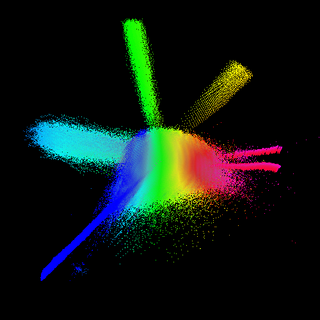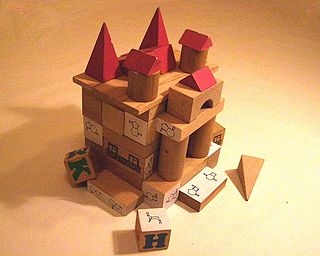A chemical database is a database specifically designed to store chemical information. This information is about chemical and crystal structures, spectra, reactions and syntheses, and thermophysical data.
Cheminformatics refers to the use of physical chemistry theory with computer and information science techniques—so called "in silico" techniques—in application to a range of descriptive and prescriptive problems in the field of chemistry, including in its applications to biology and related molecular fields. Such in silico techniques are used, for example, by pharmaceutical companies and in academic settings to aid and inform the process of drug discovery, for instance in the design of well-defined combinatorial libraries of synthetic compounds, or to assist in structure-based drug design. The methods can also be used in chemical and allied industries, and such fields as environmental science and pharmacology, where chemical processes are involved or studied.
Chemical Markup Language is an approach to managing molecular information using tools such as XML and Java. It was the first domain specific implementation based strictly on XML, first based on a DTD and later on an XML Schema, the most robust and widely used system for precise information management in many areas. It has been developed over more than a decade by Murray-Rust, Rzepa and others and has been tested in many areas and on a variety of machines.

Chemical space is a concept in cheminformatics referring to the property space spanned by all possible molecules and chemical compounds adhering to a given set of construction principles and boundary conditions. It contains millions of compounds which are readily accessible and available to researchers. It is a library used in the method of molecular docking.
Inorganic Crystal Structure Database (ICSD) is a chemical database founded in 1978 by Günter Bergerhoff and I. D. Brown. It is now produced by FIZ Karlsruhe in Europe and the U.S. National Institute of Standards and Technology. It seeks to contain information on all inorganic crystal structures published since 1913, including pure elements, minerals, metals, and intermetallic compounds. ICSD contains over 210,000 entries as of December 2020 and is updated twice a year.
This page describes mining for molecules. Since molecules may be represented by molecular graphs this is strongly related to graph mining and structured data mining. The main problem is how to represent molecules while discriminating the data instances. One way to do this is chemical similarity metrics, which has a long tradition in the field of cheminformatics.

ISIS/Draw was a chemical structure drawing program developed by MDL Information Systems. It introduced a number of file formats for the storage of chemical information that have become industry standards.

ChemDraw is a molecule editor first developed in 1985 by David A. Evans, his wife Selena 'Sally' Evans, and Stewart Rubenstein. The company was sold to PerkinElmer in the year 2011. ChemDraw, along with Chem3D and ChemFinder, is part of the ChemOffice suite of programs and is available for Macintosh and Microsoft Windows.
The SYBYL line notation or SLN is a specification for unambiguously describing the structure of chemical molecules using short ASCII strings. SLN differs from SMILES in several significant ways. SLN can specify molecules, molecular queries, and reactions in a single line notation whereas SMILES handles these through language extensions. SLN has support for relative stereochemistry, it can distinguish mixtures of enantiomers from pure molecules with pure but unresolved stereochemistry. In SMILES aromaticity is considered to be a property of both atoms and bonds whereas in SLN it is a property of bonds.
SMILES arbitrary target specification (SMARTS) is a language for specifying substructural patterns in molecules. The SMARTS line notation is expressive and allows extremely precise and transparent substructural specification and atom typing.

Chemical similarity refers to the similarity of chemical elements, molecules or chemical compounds with respect to either structural or functional qualities, i.e. the effect that the chemical compound has on reaction partners in inorganic or biological settings. Biological effects and thus also similarity of effects are usually quantified using the biological activity of a compound. In general terms, function can be related to the chemical activity of compounds.
LigandScout is computer software that allows creating three-dimensional (3D) pharmacophore models from structural data of macromolecule–ligand complexes, or from training and test sets of organic molecules. It incorporates a complete definition of 3D chemical features that describe the interaction of a bound small organic molecule (ligand) and the surrounding binding site of the macromolecule. These pharmacophores can be overlaid and superimposed using a pattern-matching based alignment algorithm that is solely based on pharmacophoric feature points instead of chemical structure. From such an overlay, shared features can be interpolated to create a so-called shared-feature pharmacophore that shares all common interactions of several binding sites/ligands or extended to create a so-called merged-feature pharmacophore. The software has been successfully used to predict new lead structures in drug design, e.g., predicting biological activity of novel human immunodeficiency virus (HIV) reverse transcriptase inhibitors.
Louis Hodes was an American mathematician, computer scientist, and cancer researcher.
Periodic systems of molecules are charts of molecules similar to the periodic table of the elements. Construction of such charts was initiated in the early 20th century and is still ongoing.
ChemWindow is a chemical structure drawing molecule editor and publishing program now published by John Wiley & Sons as of 2020, originally developed by Bio-Rad Laboratories, Inc. It was first developed by SoftShell International in the 1990s. Bio-Rad acquired this technology in 1996 and eventually made it part of their KnowItAll software product line, offering a specific ChemWindow edition of their software for structure drawing and publishing. They have also incorporated ChemWindow structure drawing components into their KnowItAll spectroscopy software packages with their DrawIt, ReportIt, and MineIt tools.
William Joseph Wiswesser was an American chemist best known as the creator of the Wiswesser line notation (WLN), which was an innovative way to represent chemical structures in a linear string of characters suitable for computer manipulation. He is also known for the Wiswesser rule, a mathematical formula that predicts the order of atomic orbitals in many-electron atoms.
The Self-Defining Text Archive and Retrieval (STAR) File, or simply the STAR File, is a text-based file format for storing structured data. It was proposed in 1991 by Sydney R. Hall. The format became widely used in molecular-structure sciences, although it is not specific to this field—it was designed as a universal approach to electronic data exchange and archiving.

Building block is a term in chemistry which is used to describe a virtual molecular fragment or a real chemical compound the molecules of which possess reactive functional groups. Building blocks are used for bottom-up modular assembly of molecular architectures: nano-particles, metal-organic frameworks, organic molecular constructs, supra-molecular complexes. Using building blocks ensures strict control of what a final compound or a (supra)molecular construct will be.

Bretherick’s Handbook of Reactive Chemical Hazards is a well-established source of information on chemical safety, often known by its author’s name, and often cited in the chemical and chemical engineering literature. In recent editions it has been in two volumes, volume 1 being individual compounds and hazardous reactions, volume 2 being groups and other information relevant to reactive chemical hazards, arranged by topic.







